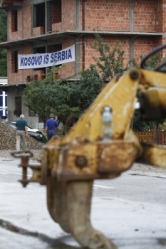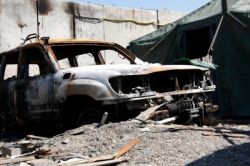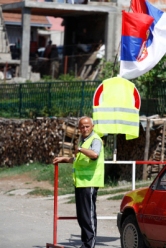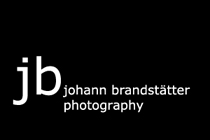
"Kosovo is Serbia", Serbia still has its structures up and running in Kosovo (www.jb-photography.org)
At the end of July an almost forgotten conflict flared up in southeastern Europe again: the Kosovo crisis was suddenly back in the headlines after police of the now-independent country blocked the import of goods from Serbia and angry Kosovo-Serbs torched buildings on a border crossing as a reaction.
(Images Copyright JB Photography)
After 16 months of war between ethnic Albanians and Serbs, a heavy-handed NATO peace enforcement operation ended the hostilities in June 1999. Since then the Kosovo Force (KFOR), a military force of about 6,500 multinational troops, has acted as a guarantor of stability. Although formally still part of Serbia, Kosovo developed its own administrative structures and finally declared full independence from Serbia on 17 February 2008. Predictably, Serbia refused to recognize the new state and continues to do so.
Ever since the end of the war, the Kosovo issue has been a smoldering crisis on the Balkans with angry accusations over various issues exchanged between Serbia and its former province regularly. At the end of July 2011 the situation quickly became dangerous, when Serbia refused to accept the newly issued Kosovo customs seals on goods that were crossing the border between the two countries.
On 21 July the government of Kosovo in turn imposed an import ban on goods from Serbia. That was not a problem for the ethnic Albanian Kosovars at all. But in the north of Kosovo the population of four municipalities consist of ethnic Serbs and these were now practically blocked from getting such basic things as food, consumer goods or medical supplies.
Lacking alternatives, the Serbs in Kosovo continued importing from Serbia as if nothing had happened. On 25 July the government in Pristina finally had enough and sent a special police unit to take control over two border crossings to Serbia.
Subsequently the events quickly got out of hand and on 27 July local Serbs torched the buildings at Jarinje border crossing, unidentified gunmen fired shots at a helicopter and at Polish KFOR-troops. At the same time, the Serbs set up roadblocks on three locations in northern Kosovo to prevent Kosovo police and customs officers, as well as KFOR from reaching the two border crossings in question.
The Republic of Serbia finds itself hanging in mid-air in the matter: on one side it does not want to stop supporting the Serbs in Kosovo, otherwise it just fulfilled one major prerequisite for joining the EU by capturing two suspected war criminals and sending them to The Hague for their trials.
Serbia saw the EU’s support for an independent Kosovo and the demand to abolish its administrative structures in the Serb-populated northern Kosovo as yet another stumbling block on Serbia’s way to join the Union. Belgrade saw itself pressed to recognize an independent Kosovo.
To understand why this is so difficult, one has to look as far back as 15 June 1389, when the armies of the Serbian Prince Lazar and the Ottoman Sultan Murad I met in battle on the Kosovo Polje, near the present-day capital Pristina. The Serbs managed to check the Turkish advance on the Balkans and farther into Europe, but Prince Lazar and most of his warriors died on the battlefield.
Ever since the Battle of Kosovo Polje, the Serbs consider this the moment of birth of their nation and even now a Serbian government that would recognize Kosovo as an independent state would quickly find itself voted out of office.
So the government of Prime Minister Mirko Cvetkovic has to perform a balancing act between its interest of getting the country into the EU, and appearing not too soft on the Kosovo issue. A difficult task that has so far been fulfilled with surprising political subtlety and skill. Gone are the days when the former Serbian strongman Slobodan Milosevic blurted his ideas about a “Greater Serbia” to the world.
Despite repeated provocation coming from the Kosovo government under Prime Minister Hashim Thaci, Serbian politicians – with very few exceptions – refused to be drawn. The Minister for Kosovo in the Serbian government, Boris Mihajlovic, said in an interview, “We are in constant contact with those countries that have not recognized Kosovo, but also with those that have, and we are lobbying to have the problem solved through dialogue [..] instead of unilateral actions that change the situation in the field.”
Finally on 19 August, the German ambassador to Serbia, Wolfram Maas, confirmed in an interview with the Serbian daily Blic, that the recognition of an independent Kosovo by Serbia was never a condition for joining the EU.
Meanwhile, the KFOR commander, German Major General Erhard Buehler, was able to bring all parties involved to the negotiating table for a series of talks in the town of Leposavic and after some Balkan-style bickering among local politicians the local Serbs cleared the roadblocks in the second week of August. The KFOR now has control over the two disputed border crossings (Jarinje and Brnjak), helped by the EU law enforcement agency EULEX. Vehicles up to 3.5 tons can cross unannounced, heavier vehicles need to be declared in advance, but at least supplies for the Serb minority are again coming into the country.
But peace remains fragile in the region. An exercise of Kosovo special police on 24 August provoked anger on the Serbian side, including threats to set up the roadblocks again. And on 26 August an 81 year old Serb, who tried to enter Kosovo on a bus from Montenegro was severely beaten by Kosovar border police because he only had his old papers, issued by the Serbian authorities.
On 2 September the talks between Serbia and Kosovo are set to continue in Brussels. The only hope is that all sides show some common sense and neither does anything to ignite that most volatile of all powder kegs on the Balkans.
(To see more images from Kosovo, click on the following links to our website: Kosovo Part 1, Kosovo Part 2)
(Johann Brandstatter, 1 Sept 2011)



